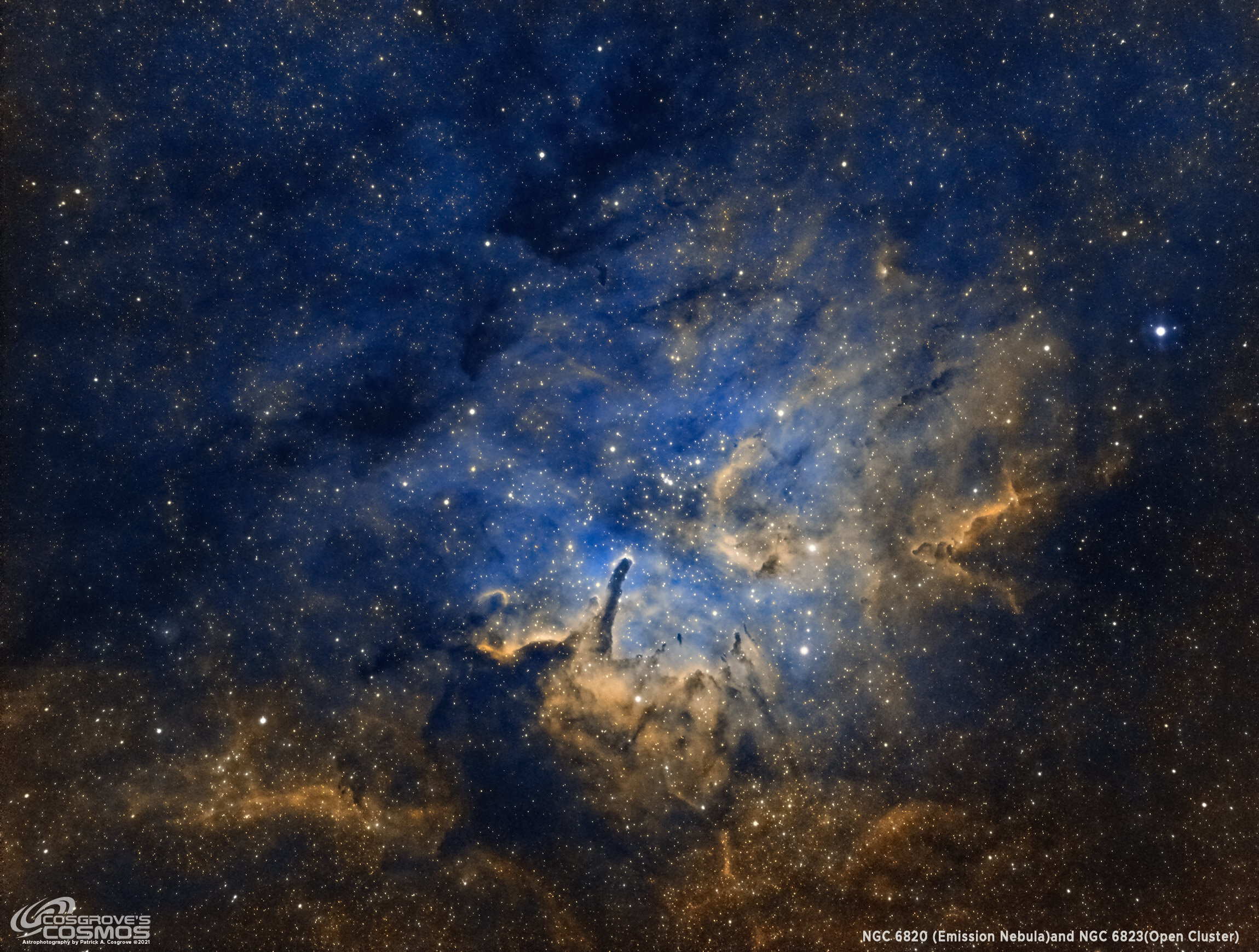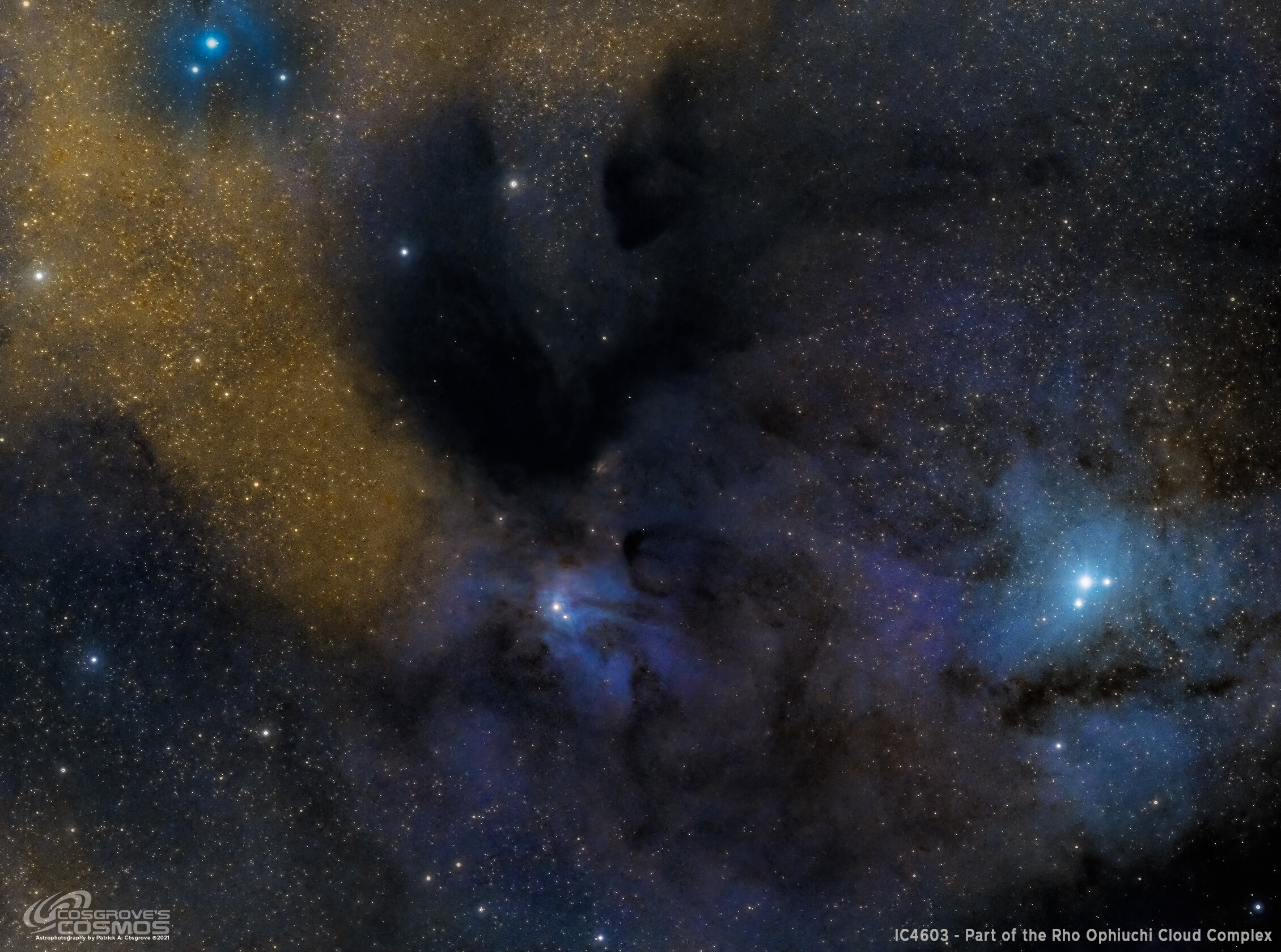Imaging Projects
In this blog, I will share the results of all of my imaging projects. The newest will be at the top and the oldest will be further down the stack. Going back in time here is interesting - some of my early stuff was pretty rough - but I did not see it that way at the time - I was thrilled to get anything back that looked like an image! Hopefully, you will see how my work has progressed with time!

Reprocessing Project: Messier 31 - The Andromeda Galaxy (6 hours in LHaRGB)
This version of M31, taken in November 2021, is my favorite. But it has been a few years since I first captured and processed this data. I have learned a lot since then, and I also have some excellent new processing tools at my disposal, so I wanted to see where I would end up if I were to start from scratch with the data, and this is the result!
Let me know what you think of this new image!

A Reprocess of SH2-157, The Lobster Claw Nebula - 4.25 hours in SHO.
SH2-157, The Lobster Claw Nebula, is located 11,000 light-years away in the constellation of Cassiopeia. This is a Reprocess Project - working with data in 2024 that was captured in 2021. I wanted to see if I could improve on this image. I think I did!

SH2-132 - A Reprocess of The Lion Nebula in SHO (8.33 hours)
This is an Image Reprocessing Project for SH2-132, also known as The Lion Nebula - whose data was originally collected in September of 2021.
The Lion Nebula is a rich HII region with star clusters, emission nebulae, and dark dust regions. Located in the southern portion of the constellation Cepheus, the Lion Nebula is roughly 10,00 light-years away in the Perseus Arm of the Milky Way Galaxy. This is a very faint and challenging target.
This image was taken on the Askar FRA400 Platform with 8.33 hours of exposure in narrowband.

Messier 81/82 Wide Field: 3.5 hours LRGB - A Failed Quest for IFN!
I decided to try using my widefield Askar FRA400 platform to image the region around M81 & M82 to try and capture IFN (integrated Flux Nebula). This effort failed miserably! The resulting image was not too bad, but I was not able to get the kind of integration needed to capture this elusive feature! While this was a major disappointment, the resulting image shows M81, M82, and a third small galaxy NGC 3077 in a very nice part of the sky.

SH2-157 The Lobster Claw Nebula - with NGC 7635 (The Bubble Nebula) in SHO - 4.25 hours.
SH@-157, The Lobster Claw Nebula, is located 11,000 light-years away in the constellation of Cassiopeia. A faint object, this was captured on the night of November 8th when I hoped to have two more nights of clear weather. That did not happen and this image was created with only 4.25 hours of data. I hope to revisit this object, collect more hours and do it justice. This was shot on my wide-field FRA400 rig and is rendered in the Hubble SHO palette.

Messier 31 - The Andromeda Galaxy in LHaRGB - 6 hours
This is my third attempt at M31. This time with a widefield system that can fit the entire galaxy into the field of view., and a mono camera that allowed me to collect Ha as well as LRGB data. A total of 6 hours of data integration.
Messier 31 is also known as NGC 224 and the Andromeda Galaxy, or as the Andromeda Nebula before we knew what galaxies were. It can be seen by the naked eye in the constellation Andromeda (how appropriate!) and is our closest galactic neighbor located 2.5 Million light-years away. It is estimated that it contains about one trillion stars - twice that of our own Milky Way.

IC 1805 - The Heart Nebula in SHO - 11.5 Hours
IC 1805 is also known as SH2-190 and more commonly as the Heart Nebula. It is located 7500 light-years away in the constellation of Cassiopeia. First discovered by William Herschel in 1787, the Heart Nebula is a region of glowing gas and dark dust lane.
This is a result of a 11.5 hour exposure on my widefield shot taken on my portable FRA400 camera platform - processed using the Hubble SHO palette.

IC 1396/1396A - The Elephant's Trunk Nebula
IC 1396, also known as The Elephant Trunk Nebula is rich region emission nebulae and dark dust regions. Located in the constellation Cepheus, the Lion Nebula is roughly 2400 light-years away.
This image was taken on the Askar FRA400 Platform with only 3 hours of exposure in narrowband - and was the first image where the FRA was used for portable operations on a trip to North Carolina.

SH2-132 The Lion Nebula in SHO (8.33 hours)
SH2-132, also known as The Lion Nebula, is a rich HII region with star clusters, emission nebulae, and dark dust regions. Located in the southern portion of the constellation Cepheus, the Lion Nebula is roughly 10,00 light-years away in the Perseus Arm of the MilkyWay Galaxy. This is a very faint and challenging target.
This image was taken on the Askar FRA400 Platform with 8.33 hours of exposure in narrowband,

NGC 6820 and NGC 6823 - An Open Cluster w/Nebula - A Grudge Match…
Located in the constellation Vulpecula, NGC 6823 is a small open cluster of stars and associated nebula, NGC 6820. The cluster is about 6000 light-years away and measures about 50 light-years across.
A year ago, I shot this, and it was one of the worst images in my collection. I came back again this year to reclaim my honor and vanquish this target foe!

NGC 7000 (The North American Nebula) with IC5070 (Pelican Nebula) in Narrowband- Total of 9.33 Hours
NGC 7000, also known as the North American Nebula and Caldwell 20, is a large H II emission nebula located in the constellation of Cygnus (The Swan). It measures roughly 2 degrees by 1.5 degrees in size, making the nebula about 10X larger than the area covered by the full moon.
Also included in this view is the Pelican Nebula IC 5070
This image is the result of 9.33 hours of integration in Narrowband and rendered in the Hubble Palette.
Extensive notes on image processing are included for the first time.

Messier 8 - The Lagoon Nebula In the Hubble Palette
Messier 8, also known as the Lagoon Nebula and NGC 6523, is a huge cloud of molecular gas and dark dust located about 4000-6000 light-years away in the constellation Sagittarius. This is a large emission nebula that is bright enough to be seen with the naked eye. Within the cloud is the open cluster NGC 6530, and a bright central feature is known as the Hour Glass.
This is my third effort on this target - a mono image in SHO - working from minimal data taken the troubling month o July 2021

Messier 24 - The Small Sagittarius Star Cloud - in Widefield LRGB
Messier 24, also known as IC 4715 and “The Small Sagittarius Star Cloud,” is located appropriately in the constellation Sagittarius. It appears as a large and dense population of stars with a few areas of dark dust. As we look towards Sagittarius, we are looking towards the highly populated core of our own galaxy. Unfortunately, we don’t see the core as many molecular gases, and dark dust clouds obscure our view. However, in the case of Messier 24, what we are actually seeing is a hole in the obscuring gas and dust, and we get a glimpse of the dense stars of the Sagittarius-Carina arms of the Milky Way.

Revisiting the Draco Triplet: NGC 5981, NGC 5982, & NGC 5985
The Draco Trio consists of a close grouping of three very different looking galaxies, found in the constellation Draco. These are small targets for my scope so I needed to carefully process the images to get the most detail possible. See how I did it!

IC4603/4604 and a Portion of the Rho Ophiuchi Cloud Complex in LRGB
The Rho Ophiuchi cloud complex is a dark nebula of gas and dust that is located near the star Rho Ophiuchi of the constellation Ophiuchus. At an estimated distance of 460 light-years, it is one of the closest star-forming regions to our Solar System. This region is quite large, covering an angular area of the sky that measures 4.5 x 6.5 degrees in size.

C49: The Rosette Nebula in SHO
Astrobin Top Pick!
Also known as the "Skull Nebula" and Caldwell 49, the Rosette Nebula is a large HII region of bright gas and filaments of dark dust, located in the constellation of Monoceros. The open cluster NGC 2244 (discovered by John Flamsteed in 1690) is associated with this region - the stars of which were formed within this molecular cloud. Located 5000 light years away, and measuring 65 light years in diameter,

NGC 4631 - The Whale and the Hockey Stick (NGC 4656) - A second attempt, this time in LRGB-Ha…
The Whale and the Hockeystick are two galaxies are found in the constellation Canes Venatici, about 30 Million Light years away. This is my second time shooting this target and the first where I used a mono camera and captured LRGB along with some Ha subs folded in for good measure. As it worked out, I captured a possible supernova that was recently discovered as well.

Messier 81: Bode's Galaxy and Messier 82: the Cigar Galaxy
Messier 81, also known as NGC 3031 and Bode's Galaxy, is a beautiful spiral galaxy located 12 Million light years away in the constellation Ursa Major. This post tells the story of this capture -which consists of 9.9 hours of integration using the ZWO ASI294MC-Pro and the William Optics 132mm FLT APO Platform.

Messier 65, 66, and NGC 3628: The Leo Triplet
The Leo Triplet, also known as the M66 group, is a small group of galaxies located about 35 million light-years away in the constellation Leo. The three prominent galaxies involved are M65 (bottom left), M66 (top left), and NGC 3628 (right). 2.9-hour integration on the William Optics 132mm Telescope Platform

NGC 7380 - The Wizard Nebula - in Hubble Palette with Mixed Narrowband and RGB Filters
NGC 7380, Also known as the Wizard Nebula, the Flying Horse Nebula, and Sh2-142, is a gas, dust, and young star region. Located 7200 light-years away in the constellation Cepheus, the Wizard Nebula is tough to see visually but is a favorite imaging target. Most people have no trouble making out the Wizard - wearing a pointed hat, a well-defined nose, and a bright blue star for his eye. He also appears to be wearing a cloak and posing with his hands and fingers outstretched. FIrst complete Narrowband image attempted.
